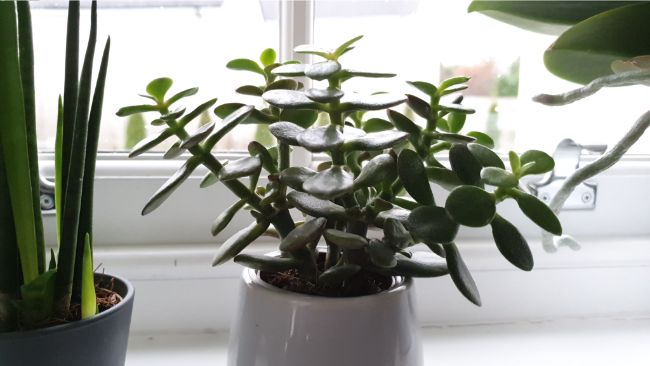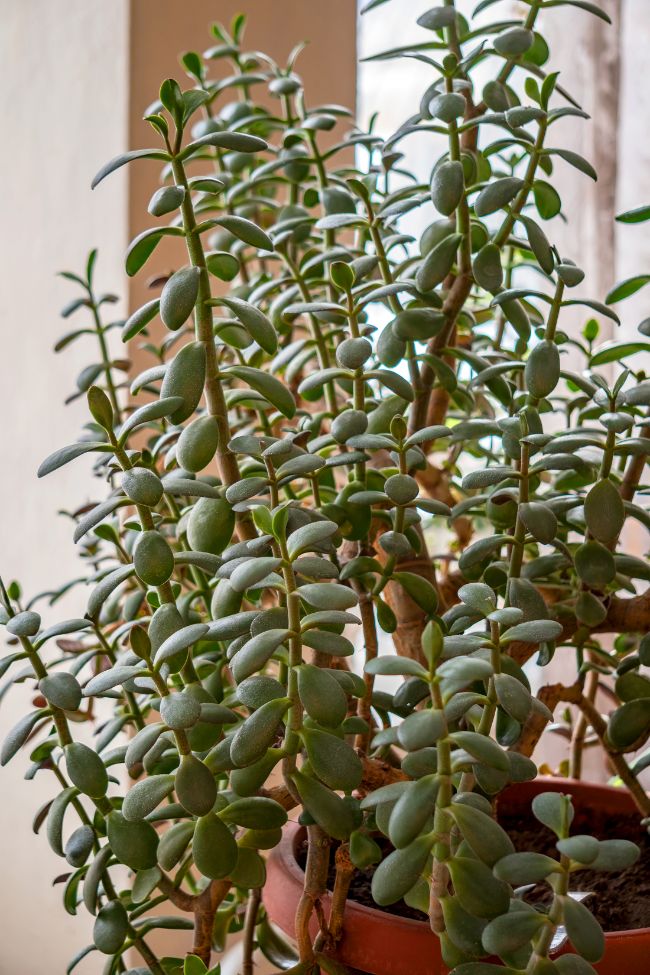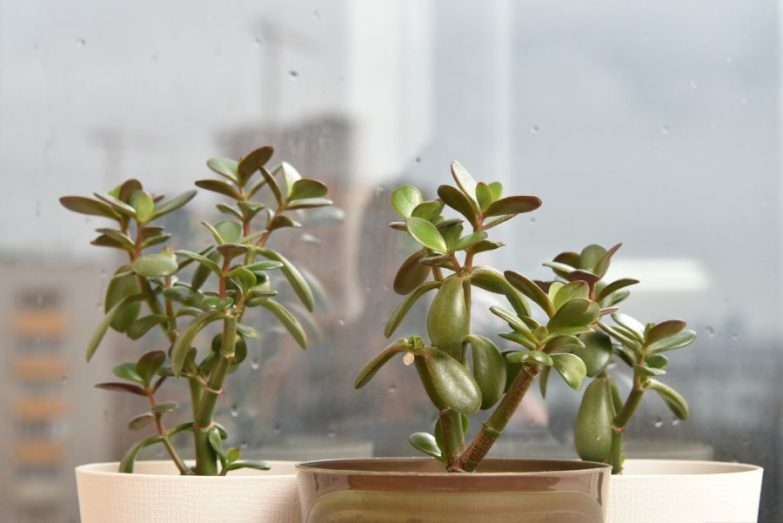Jade plants (Crassula ovata) are commonly grown as houseplants not only because they are easy succulents to grow, but they are also seen as an emblem of good luck or prosperity. One of the challenges is keeping them from stretching out between the leaves. This article is going to show you how to fix a leggy jade plant, and to prevent it from stretching in the first place.
How to fix a leggy jade plant? Fix your leggy jade plant by selectively pruning stretched stems to encourage new growth, or pinch off the growing tips on the stems. Prevent leggy growth by providing more sunlight or supplementing its growth with a grow light. Ensure that you are meeting the general care needs of your plant to promote strong, compact growth.
In order to fix a leggy jade plant or prevent it from happening, it’s important you understand the reasons why your plant has become stretched.
Why Does A Jade Plant Become Leggy?
Typically jade plants become leggy from a lack of sunlight triggering the plant’s natural defense to “reach” towards the sun. Insufficient light causes the nodes between the leaves to stretch or elongated more than normal. Instead of a compact, full-looking plant, your plant looks spindly and unhealthy. It may be accompanied by a thinning of the stem and an overall lightening of the plant’s green color.
This is primarily due to a phenomenon known as etiolation, resulting from a lack of sunlight.
Etiolation is a process that evolved from plants growing in partial or complete lack of light. The growing tips are strongly attracted to light, and as a defense mechanism for survival (light is needed for photosynthesis after all), phytohormones will elongate the stems of the plants in an attempt to reach towards the light source.
In cases where plants are growing under leaf litter or under the shade canopy of other plants this rapid, leggy growth may be the difference between survival and perishing.
In houseplants, the situation usually isn’t so dire but the resulting aesthetics of a leggy jade plant aren’t as desirable as a compact, bushy plant so it’s important to prevent and/or fix legginess.

How To Treat A Leggy Jade Plant
Once your jade starts getting leggy, it is possible to treat it, creating a full, bushier plant. However, this isn’t a quick process due to the slow-growing nature of succulents.
Give It More Sunlight
This seems like a simple solution and it’s the first thing you should try to do.
Watch your window during the day to determine how much light your plant receives and whether the window is shaded for part of the day.
Many people overestimate the amount of sunlight a given location gets. Once you have a good idea which window has the most light, move your jade plant to it.
Move it closer to the windowpane without touching the glass. Distance from the window make a dramatic impact on the amount of light reaching your jade plant. Even moving a plant 2 to 3 feet away from a window reduces the light intensity by about half, compared to being right on a windowsill.
Make sure your windows are clean, so as much light comes in through the window as possible.
Provide Supplemental Light With A Grow Light
If you live in a house or apartment that doesn’t get good light exposure, or during the winter months, it might be necessary to supplement your plants with a grow light. Grow lights are available in a range of sizes and prices to fit your space and budget.
LED or fluorescent grow lights are ideal for providing extra light for your more demanding houseplants.
Reduce The Temperature Around The Plant
When grown outdoors, a drop in temperature corresponds with shortening daylength, i.e. a decrease in the amount of light the plant gets. As a natural preventative against etiolation, plants go dormant during the cooler months when sun exposure is less.
Dropping the temperature, or moving the jade plant to a room with cooler temps – but maintaining high light conditions – will slow growth down to create shorter nodes between leaves.
Pinch off the growing tip on the stems. When the meristem, a cluster of cells responsible for growth, is pinched off the top it triggers hormones that initiate lateral growing points on the stem.
Instead of continuing to grow upwards desperately reaching for light the clusters of cells on the stems will begin to grow outwards, creating more lateral branches to result in a bushier plant.
Prune the top off of leggy stems removing the stem down to just above what is known as a leaf scar. This is an area where there are brown rings around the stem. This will also encourage fuller, bushier growth by initiating hormones that will cause lateral branching. You can then also take the top you removed and propagate it to create a new plant.

How To Prevent Your Jade Plant Stretching
Taking good care of your jade plant overall is the best thing you can do to preventing legginess. When its basic needs are met the plant will grow strong and healthy, naturally preventing legginess. Here are some tips to help you ensure your jade plant grows strongly.
Sunlight
Jade plants need a tremendous amount of sun to keep them growing well without getting leggy. At a minimum, they prefer 4 to 6 hours of sunlight daily; indirect, yet bright light is best as too much direct light can cause sunburn on the leaves.
Place your jade plant in a south-facing window if possible and your plant will grow full and bushy. If you do not have a south-facing window, a window with western exposure is the second-best option.
Temperature
Jade plants thrive in normal indoor conditions, with temperatures ranging from 65 to 75℉ during the day and 50 to 55℉ at night. Jade plants will stop growing if temperatures exceed 90℉, and can survive almost down to freezing if the soil is dry.
Cooler temperatures will generally encourage slower, more compact growth, and coupled with high light levels, will produce a really compact, bushy plant.
Watering
Jade plants prefer to have their soil on the dry side, and one of the common problems homeowners see is rotting at the base of the stems due to overwatering.
A chronically overwatered jade plant will grow weakly, with thin spindly stems and yellowing foliage. Excessive watering over time will lead to your jade plant looking leggy due to poor health.
Only water jade plants when the growing media is thoroughly dry, especially during the fall and winter when plants are dormant; then water thoroughly until water freely drains out the holes in the bottom of the container.
To keep the roots of your jade plants from being too wet, opt for a growing media designed for succulents and grow them in clay containers. Potting mixes for succulents usually contain a higher amount of sand so water drains quicker. Clay containers are more porous than plastic pots and allow for better air movement through the root zone.
Read more about how to master the art of watering houseplants in this article.
Fertilizer
Jade plants will benefit from a dose of fertilizer every now and then if they are actively growing. They do have low fertilizer requirements, but prolonged deficiency will lead to weak growth and your jade plant developing a leggy appearance.
During their active growing season follow the label directions on a succulent specific fertilizer. Skip the fertilizer during the fall and winter.
Pruning
Using a pair of clean sharp scissors or bonsai pruning shears, periodically remove new growth. Removing the tips of the stems will encourage your plant to grow thicker and bushier instead of taller.
The great thing about jade plants is that even if you don’t quite have the perfect light conditions, you can compensate for this with regular pruning. Your jade plant will maintain bushy growth, preventing it from ever becoming leggy.
Pest Management
Typically, jade plants have little problems with pests unless they are in a humid environment or the soil is kept too moist. A pest affected jade plant will lack the vigor to produce robust growth and will start to look a spindly over time.
When grown indoors and overwatered, jade plants can see infestations from scale, whiteflies, and mealybugs. Routinely check your plants looking for bugs.
If you do find any pests immediately remove them manually to prevent further damage or treat the plant. Neem oil, an organic pesticide is effective at treating soft-bodied insects. Read more about how to get rid of houseplant pests naturally in this article.
Repotting
Every couple of years it’s good to repot your jade plant into a slightly larger container and refresh the potting soil. This prevents the roots from becoming too constricted in a small space, or root-bound. Each time you repot the plant gently remove as much growing media from the root system as you can. Move the jade plant into a container about 2-inches in diameter larger than the previous.
Preventing your jade plant becoming leggy isn’t too difficult and is much easier than having to fix a jade plant that has become very leggy over time. Just remember to provide lots of light, prune regularly and ensure you are watering properly.


